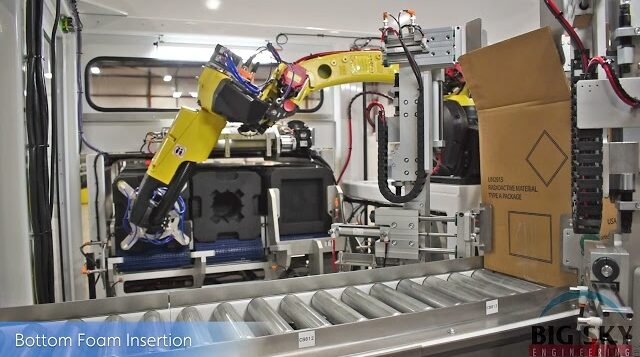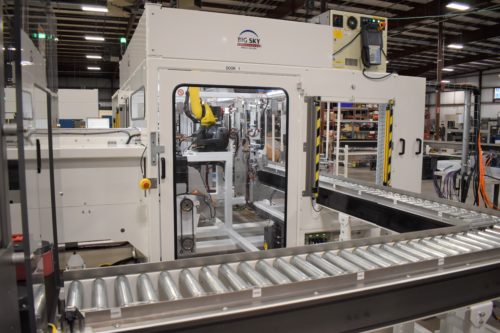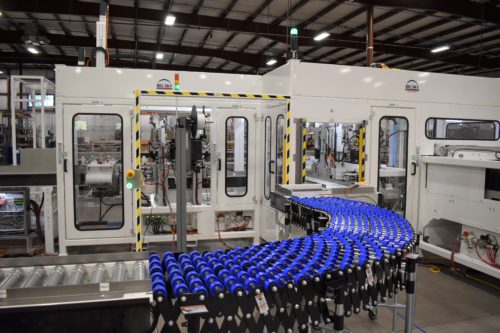SITUATION
The purchasing customer expressed the desire to create a packaging line for its medical containers. The line would require integrating multiple types of packaging equipment fitting the machine, and integrated equipment into a tight working envelope.
OPPORTUNITY & IMPLEMENTATION
The project requirements included the machine being completely autonomous aside from placing foam parts and information packets into the in-feed conveyor. At its core, the requirements are to assemble and package 2 boxes per minute. The assembly and labeling process required 100% reliability and accuracy. The medical canister weighs 100lb, and all conveyors and components were designed to withstand heavy continuous workloads.
Final Station Summary:
Case Erector- The integrated case erector continually erects cases until the carton in-feed conveyor sends the full signal. The case erector magazine allows the operators to load multiple flattened cartons onto the carton magazine at one time.
Carton Infeed- Cartons travel to the bottom foam insertion point. Cartons are staged prior to entering the carton insertion zone.
Bottom Foam Insertion- Clamps and locates securely the carton in the bottom foam insertion zone. The robot picks the bottom foam piece from the foam in-feed conveyor. The bottom foam piece is placed at the bottom of the carton.
Metal Canister Insertion- The clamps and locates secure the box in preparation for metal canister insertion. A multiple-axis gantry picks and places the metal canister into the bottom foam insert inside of the carton. Barcode readers collect data from the canister and the carton. The shipping label is applied at the metal canister insertion zone. Upon completion of the canister insertion and the shipping label process, the carton will travel to the top foam kit insertion zone.
Top Foam Insertion- Clamps and locates secure the carton in the top foam insertion zone. The robot picks two top foam parts from the foam in-feed conveyor. The robot places the top foam pieces onto the carton. Upon completion of the top foam kits, the clamps and locates are released, and the box travels outside of the machine to the carton sealing machine.
Case Sealer- The case sealing machine tapes the top edges of the carton. The carton transitions through the machine and to the out-feed conveyor section.
Product Scan- The carton with the canister installed stops at the conveyor zone following the top tape application. The product is read by the measurement systems to determine its internal contents.
Label Rotate Table- The carton stops at the rotate table station. The table rotates, and the operator applies the documents to the carton. Upon applying the pouch, the operator selects the green or red hard-wired pushbuttons to verify the cartons’ good or rejected status. The rotating table activates, and the carton travels to the proceeding conveyor zones.
DOT Rotate Table- The carton enters the dot label application rotate the table. The carton barcodes are scanned, and the rotate table activates. The integrated labeler applies the DOT label to the specified carton location. Upon completing the DOT label, the rotate table triggers, returning to its home position, and the completed carton moves to the staging area to be palletized.
DESIGN FEATURES & SPECIFICATIONS
- Fanuc 6 AXIS M-10ID Robot cell
- Integrated Case Erector
- Integrated Case Sealer
- Integrated Label Applicator
- 3-Axis Gantry and Canister Transfer Conveyor
- 5 row Foam and Packet In-Feed Conveyor
- Carton Orientation Vision Systems & Product barcode scans.
- The machine HMI uses customary pictures & buttons for control overrides. All machine sequences can be
operated in manual mode on the HMI. Current cycle rates and station information are displayed on the main
screen display.
Approximate Machine Dimensions: 24’L x 51’W x 11’H
Power Requirements: 480VAC, 3 Phase, 60A
Pneumatic Requirements: 80PSI-10 SCFM




